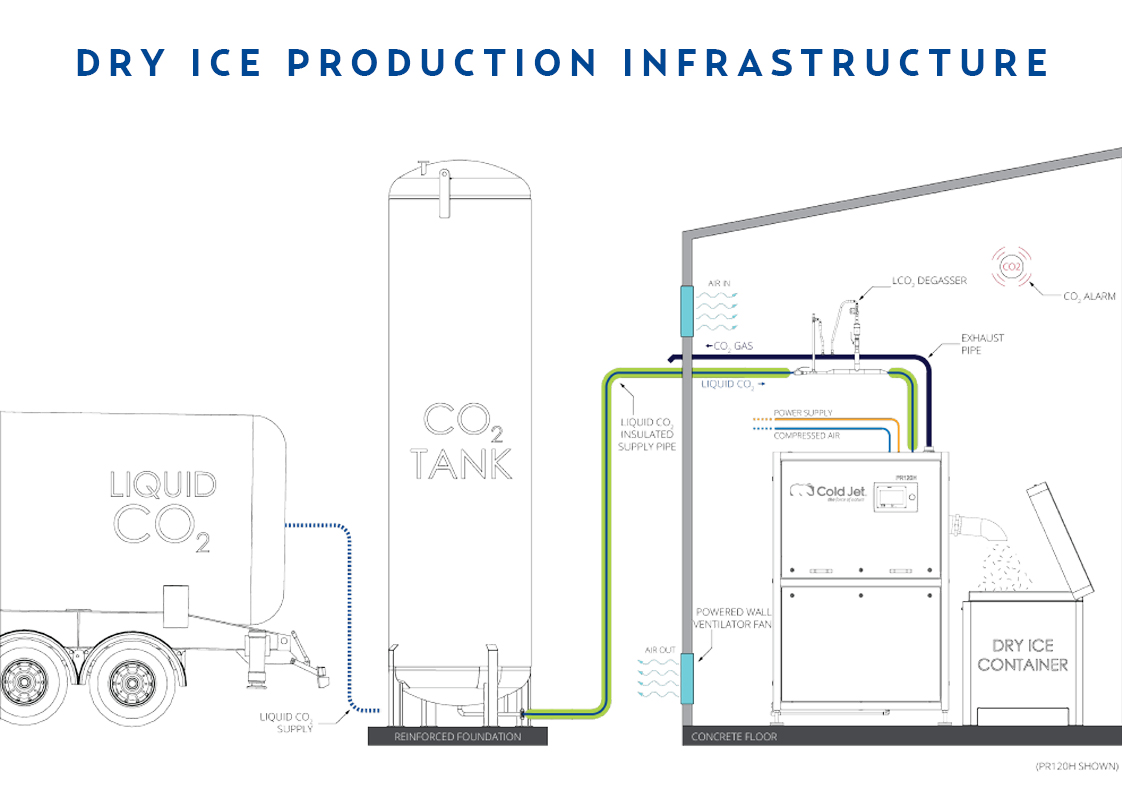
Answers to your questions about dry ice
Dry ice, the solid form of carbon dioxide, plays a critical role across numerous industries and applications, from pharmaceutical shipping and food preservation to industrial cleaning and special effects production.
This article addresses the most frequently asked questions about dry ice, covering everything from its fundamental characteristics and proper handling procedures to storage requirements and safety protocols.
What is dry ice?
Dry ice is the solid form of CO2.
Dry ice is the product of a carbon capture and utilization process. The process takes CO2 that was captured during industrial processes and recycles it. This CO2 would have otherwise been discarded into the atmosphere as industrial waste.
Dry ice provides further economic and environmental value by eliminating negative externalities of common sanitation, parts finishing, surface preparation, and transport cooling processes, such as environmental and health effects from chemical use, unnecessary water use, additional greenhouse gas emissions via refrigerated trucks, and additional waste from cleaning rags/pads.
How cold is dry ice?
Dry ice has a very low temperature, around −109.3°F (−78.5°C), which makes it an excellent cooling and cleaning medium.
How is dry ice made?
Dry ice is made by pumping pressurized liquid CO2 into a dry ice production machine. These machines rapidly depressurize CO2, which turns the liquid CO2 into a CO2 snow. This CO2 snow is then compressed into a solid form - making dry ice.
Learn more about how dry ice is made.

Where do I get dry ice?
Dry ice pellets or blocks can be ordered from industrial gas suppliers, welding supply companies and other regional suppliers. Dry ice can be picked up directly from suppliers, or most major metropolitan areas have regular delivery trucks that cover a 100 mile radius. Dry ice can also be shipped using a common carrier and it is delivered in insulated containers.
Can I make my own dry ice?
Dry ice can be produced on demand using a dry ice production machine, also known as a pelletizer, slice maker, or reformer.
Producing your own dry ice must be economically viable and the amount of dry ice used on a daily and weekly basis must be considered.
To make dry ice at your facility, you will need the proper infrastructure, such as a bulk CO2 tank, proper piping, a dry ice production machine, and an optional CO2 recovery system (capture excess CO2 and recycle it for increased efficiency).
Learn more about needed infrastructure here.
Once proper infrastructure is in place, you will need to identify a liquid CO2 supplier. Liquid CO2 can be supplied by an industrial gas company, specialty gas distributors, or regional providers.

How do I store dry ice and how long does it last?
Dry ice should be stored in an insulated container, which is provided by the supplier and picked up by them at your next delivery. The thicker the insulation, the slower it will sublimate.
Depending on the climate and thickness of your container, typical dry ice sublimation is approximately 2% to 10% per day. Dry ice will last for up to a week if it's properly stored in an insulated container.
.jpg?width=2560&name=blocks%20of%20dry%20ice%20(2).jpg)
What is dry ice used for?
In industrial and manufacturing settings, dry ice is used in a variety of applications and industries.
- Industrial cleaning with dry ice blasting
- Deburring and deflashing parts
- Surface preparation prior to painting or coating
- Preserving food during processing and production
- Keeping food items frozen during shipment
- Maintaining critical temperatures for medical and pharmaceutical shipments
How much dry ice do I need?
The amount of dry ice you need varies and is greatly dependent on what you are using it for.
Dry ice for cooling
The optimal amount of dry ice needed to cool a food shipment is a dynamic calculation, typically falling within the range of 5-10 lbs per 24 hours in an insulated cooler, but this varies significantly based on several key factors.
These include the shipment's duration (longer transit times require more dry ice, with an extra 24 hours' worth often recommended for contingencies), the quality of insulation in the packaging (thicker, high-performance materials like vacuum insulated panels reduce sublimation), ambient temperatures during transit (hotter conditions demand more dry ice), and the desired temperature of the food (frozen items need direct contact and more dry ice than merely chilled ones).
The form of dry ice also plays a role, with blocks and slabs lasting longer than pellets due to a lower surface area.
Dry ice blasting
For dry ice blasting, the amount of dry ice needed to clean effectively varies from application to application and also can vary dramatically with each dry ice blasting system.
The average dry ice consumption for dry ice blasting equipment will range from approximately 0.7 lbs (0.32 kg) per minute for a MicroParticle system to 2 1/2 lbs (1.1 kg) per minute for a pellet system.
How much does dry ice cost?
The cost of dry ice generally ranges from $.60 to $3.00 per pound, but it is a commodity and prices vary geographically.
Is dry ice safe?
Dry ice is the solid form of carbon dioxide. It is safe when used and stored correctly.
Dry ice requires careful handling with insulated gloves. You must also ensure proper ventilation and that you store it in well-ventilated, non-airtight containers to prevent pressure buildup. These precautions are easily managed.
For more information on safety precautions you can take with dry ice, click here.
Are there special precautions to take when using dry ice?
When working with dry ice, special precautions must be taken to ensure the area is sufficiently ventilated and that proper PPE is used when dealing with the liquid or solid form of CO2 (dry ice). Some safety precautions include:
- Proper ventilation where dry ice is stored
- Monitor and limit exposure to CO2
- Follow safety guidelines provided by your dry ice distributor
- Identify and label areas where dry ice is stored
- Utilize proper PPE when handling dry ice
- Stay alert and be aware
How do I dispose of dry ice?
In order to safely dispose of dry ice, place the dry ice in a well-ventilated area at room temperature and allow the dry ice to sublimate naturally.
Never dispose of dry ice in a trash bin, chemical waste container, or other waste can. Never dispose of dry ice in a sink, toilet, or other fixture as the temperature difference can destroy plumbing infrastructure.
Have more questions about dry ice and how it's used? Check out our Definitive Guide to Dry Ice Blasting!
.png) English
English


